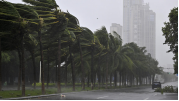
Super typhoon Yagi, the most powerful autumn typhoon to strike the Chinese mainland since the establishment of the People’s Republic of China, landed in South China’s Hainan province on Friday. The name Yagi has been used to name five tropical cyclones (气旋) in the northwestern Pacific Ocean. Japan submitted the name, which is the Japanese word for goat and the Japanese name of the constellation (星座) Capricornus. Hurricane or Typhoon? How tropical cyclones get their names?
1.How does the author introduce the topic of the text?
A By posing a contrast.
B By making an appeal.
C By reporting an event.
D By assuming a situation.
解析:选C。C 推理判断题。根据第一段中作者提到的台风“摩羯”这一新闻事件可知,作者通过该事件引出台风命名这一话题。故选C。
2.How was the Great Galveston Hurricane named?
A By its origin area.
B By its landing time.
C By its founder’s name.
D By its landing location.
解析:选D。D 细节理解题。根据第二段的“the hurricane that destroyed Galveston in 1900”1900年摧毁加尔维斯顿的飓风,即该飓风在加尔维斯顿登陆;由此可知,1900年加尔维斯顿飓风是根据其登陆地命名的。故选D。
3.During World War II, storms were named after________.
A females
B males
C politicians
D famous figures
解析:选A。A 细节理解题。根据第三段中的“The modern system of using personal names developed during World War II, when meteorologists began using women’s names”可知,二战期间,气象学家开始用女性的名字给风暴命名。故选A。
4.Which sentence can be put back into the “____△____”?
A How to survive disasters like typhoons?
B How are storm names picked today?
C What are the features of storms?
D How do tropical storms form?
解析:选B。B 段落大意题。根据最后一段内容,尤其是“maintains lists of names to be used for tropical cyclones”“For the Atlantic basin there are six alphabetical lists of 21 names each”“For the Western Pacific/South China Sea basin, names on the lists are”等可知,该段主要讲的是现在的风暴是如何命名的。故选B。